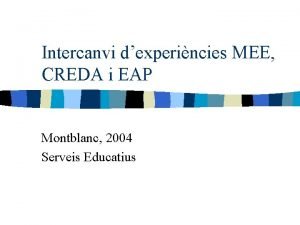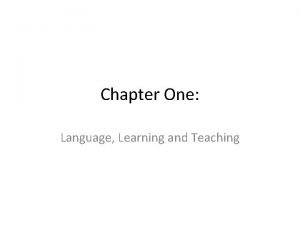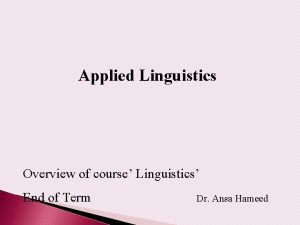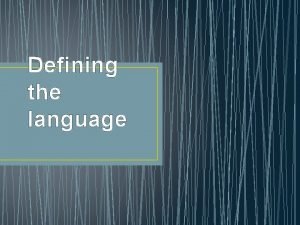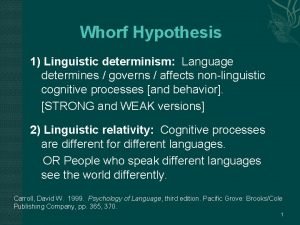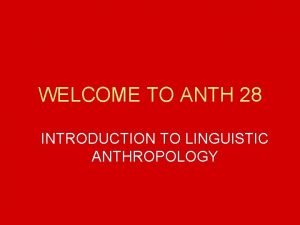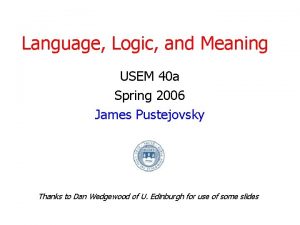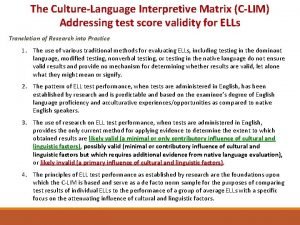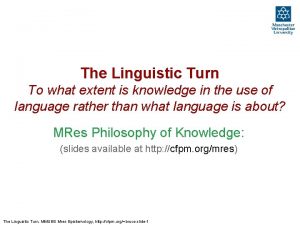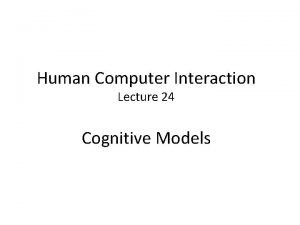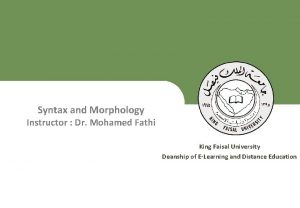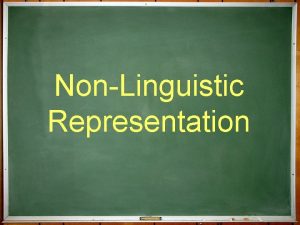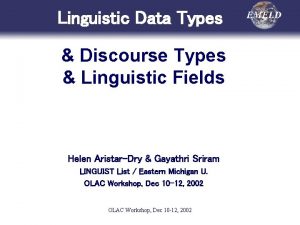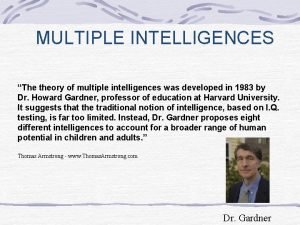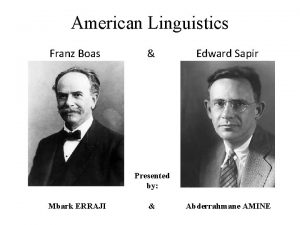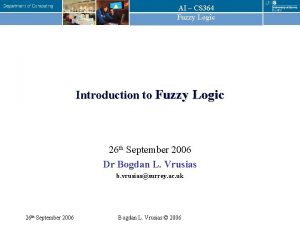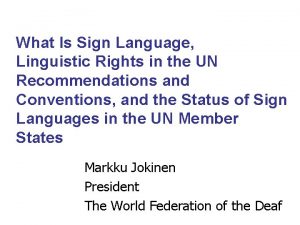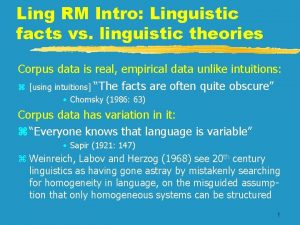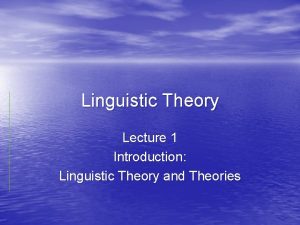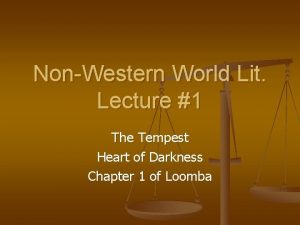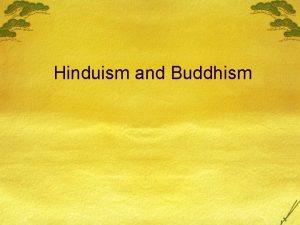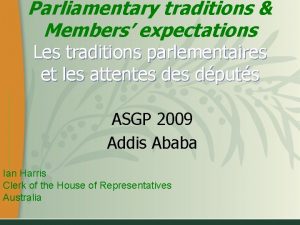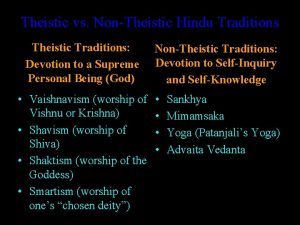NonWestern Traditions Survey of Linguistic Theories Lecture 2









![Devanagari [ˌdeɪvəˈnɑːɡəriː]; Hindustani: [d eːʋˈnaːɡri]; दवन गर • Also Nagari (Nāgarī, ����� ): an Devanagari [ˌdeɪvəˈnɑːɡəriː]; Hindustani: [d eːʋˈnaːɡri]; दवन गर • Also Nagari (Nāgarī, ����� ): an](https://slidetodoc.com/presentation_image_h2/6141ba3933453b41ba7326b7cfd476a5/image-10.jpg)



![The Earliest Indian Grammarians (VIII–VI BCE) • The Sanskrit grammatical tradition of vyākaraṇa [ʋjɑːkərəɳə] The Earliest Indian Grammarians (VIII–VI BCE) • The Sanskrit grammatical tradition of vyākaraṇa [ʋjɑːkərəɳə]](https://slidetodoc.com/presentation_image_h2/6141ba3933453b41ba7326b7cfd476a5/image-14.jpg)
























- Slides: 38

Non-Western Traditions Survey of Linguistic Theories Lecture 2, 2020 Olga Temple Linguistics & Modern Languages SHSS UPNG

Non-Western Traditions • People have wondered about language throughout recorded history and beyond • In many cultures, linguistic analysis was part of religious studies and writings (i. e. , the sacred texts in Hebrew, Sanskrit and Arabic). • It appears that linguistic thought arose in only a few societies: 1. Ancient India 2. China 3. Mesopotamia [apart from Ancient Greece]

Ancient India: the Vedas

~ 1500 – 1000 BCE, Indo-Aryan tribes settled in the northwestern parts of India. After 1200 BCE, the ‘Vedic civilization’ (mostly tribal societies) spread to the Ganges Plain. Society became increasingly settled and agricultural, with a hierarchy of four social classes, and the emergence of monarchical citystates.

The Vedic period (c. 1500 – c. 500 BCE) • The Vedas (Sanskrit ��� véda, "knowledge“; the oldest scriptures of Hinduism); the oldest of them, the Rigveda, claims that vāk (speech) is god-inspired. • By 1200 BC, the oral tradition of reciting the Vedas word-to-word and sound-to sound became an essential part of Indian education. • Sanskrit was an oral language – amazingly, it was transmitted (through reciting the Vedas) unchanged for hundreds of years.

The Vedas (Sanskrit ��� véda, "knowledge") are a large body of texts originating in ancient India. Composed in Vedic Sanskrit, the texts constitute the oldest layer of Sanskrit literature and the oldest scriptures of Hinduism (Wikipedia). The Sanskrit word véda "knowledge, wisdom" is derived from the root vid - "to know". This is reconstructed as being derived from the PIE root *uveid-, meaning "see" or "know" (Ibid. ).


Writing in Sanskrit • The Brahmi script is one of the most important writing systems in the world by virtue of its time depth and influence. • Most of the earliest historical texts in India are written in Brahmi. • The 'Devanagari* Script' (���� ), which is now commonly used for Sanskrit, has existed for less than a thousand years. * [ˌdeɪvəˈnɑːɡəriː] / [d eːʋˈnaːɡri]

International Alphabet of Sanskrit Transliteration (I. A. S. T. )
![Devanagari ˌdeɪvəˈnɑːɡəriː Hindustani d eːʋˈnaːɡri दवन गर Also Nagari Nāgarī an Devanagari [ˌdeɪvəˈnɑːɡəriː]; Hindustani: [d eːʋˈnaːɡri]; दवन गर • Also Nagari (Nāgarī, ����� ): an](https://slidetodoc.com/presentation_image_h2/6141ba3933453b41ba7326b7cfd476a5/image-10.jpg)
Devanagari [ˌdeɪvəˈnɑːɡəriː]; Hindustani: [d eːʋˈnaːɡri]; दवन गर • Also Nagari (Nāgarī, ����� ): an alphasyllabary alphabet of India and Nepal; Rooted in Brahmi; earliest epigraphical evidence – 1 st to 4 th centuries CE; in regular use by the 7 th century CE; fully developed by 10 th century CE. • Written from left to right, has symmetrical rounded shapes within squared outlines, & horizontal line that runs along the top of full letters. • Used by >120 languages, i. e. Hindi, Marathi, Nepali, Pali, etc. ; also for classical Sanskrit. • “Phonetic” script; 47 primary characters: 14 vowels and 33 consonants; no capital or small letters (as in Latin)

Vedanga: the "limbs of the Veda" • Treatises on how to recite and interpret the sacred texts ‘correctly’ (vernaculars were very different from the ‘original’ Sanskrit). • Analysis of Sanskrit grammar, describing the structure of Sanskrit words by splitting compounds into words, stems, and phonetic units – the beginnings of morphology and phonetics, which had a great influence on Western linguistics over 2000 years later. • Focus on the description and analysis of Sanskrit (perfect/complete), not on linguistic change over time.

Vedanga: the "limbs of the Veda" • Six technical subjects related to the Vedas: Phonetics (Śikṣā), Ritual (Kalpa), Grammar (Vyākaraṇa), Etymology (Nirukta), Meter (Chandas), & Astronomy (Jyotiṣa) • Auxiliary to the Vedas: designed to aid in the correct pronunciation and interpretation of the text • Treated in Sūtra literature dating from around 500 to 250 BCE.

![The Earliest Indian Grammarians VIIIVI BCE The Sanskrit grammatical tradition of vyākaraṇa ʋjɑːkərəɳə The Earliest Indian Grammarians (VIII–VI BCE) • The Sanskrit grammatical tradition of vyākaraṇa [ʋjɑːkərəɳə]](https://slidetodoc.com/presentation_image_h2/6141ba3933453b41ba7326b7cfd476a5/image-14.jpg)
The Earliest Indian Grammarians (VIII–VI BCE) • The Sanskrit grammatical tradition of vyākaraṇa [ʋjɑːkərəɳə] < need for strict interpretation of the Vedic texts. • Sakatayana (~8 th century BCE) & Yaska (c. 6 th or 5 th century BCE). • Sakatayana claimed that most nouns are derived from verbs. • In Nirukta, Yaska supported this view based on the large number of nouns that were derived from verbs through a derivation process.

Yāska’s 4 main word categories: 1. nāma – nouns or substantives 2. ākhyāta – verbs 3. upasarga – pre-verbs or prefixes 4. nipāta – invariant words (perhaps prepositions)

Words as carriers of meaning: atomism vs. holism debate raged for over 1200 years • Atomism: words are the primary elements out of which the sentence is constructed, • Holism: the sentence is the primary entity, and the word can only be understood in the context of utterance • Principle of Compositionality in descriptive linguistics • “Traditional semantics” vs. “cognitive linguistics”: cognitive linguists’ view of semantics is that any definition of a word ultimately constrains its meaning because the actual meaning of a word can only be construed by considering a large number of individual contextual cues.

Pāṇini (c. 5 -4 th c. BC) Pānini’s grammar of Sanskrit (600 B. C. - 300 B. C. ); • Famous for economy of expression – described the whole of Sanskrit grammar in just 4, 000 consequential aphoristic rules or sutras (strings), each building on the previous one. • Translated in 1891

Pāṇini is considered to be "the father of linguistics“; his grammar influenced foundational scholars such as Ferdinand de Saussure and Leonard Bloomfield. Pāṇini likely lived in Shalatula in ancient Gandhara in the northwest Indian subcontinent, during the Mahajanapada era. By Avantiputra 7 - Own work, CC BY-SA 3. 0, https: //commons. wikimedia. org/w/index. php? curid=33202412

A 17 th-century birch bark manuscript of Panini's grammar treatise from Kashmir:

Panini’s Sutras 1. Mapped the semantics of verb argument structures into thematic roles, which express time-space and causal relationships between the major sentence constituents (S/V/O) 2. Provided morphosyntactic rules for creating verb forms (conjugations) and noun forms whose seven cases generate the morphology of noun inflections (declensions) 3. Analyzed how these morphological structures are influenced by phonological processes (e. g. , root or stem modification).

‘Phoneme’ concept The phonological structure Panini outlined includes defining a notion of sound universals similar to the modern conception of phoneme, the systematization of consonants based on oral cavity constriction, and vowels based on their height and duration. Many scholars believe, however, that it is his idea of constructing word and sentence meanings from morphemes that is ‘truly remarkable in modern terms’ (Source: http: //en. wikipedia. org/wiki/History_of_linguistics; retrieved March 27, 2010).

Bhartrhari (c. 6 -7 th century AD) A 1000 years after Panini, developed a remarkably insightful philosophy of meaning. His work Vākyapadīya (literally, “On Words and Sentences”) expounds his doctrine of Sphoṭa (bursting, opening) and states that a sentence should be interpreted as a single unit which "conveys its meaning 'in a flash', just as a picture is first perceived as a unity, notwithstanding subsequent analysis into its component coloured shapes" (Robins 1997: 173). He claimed that the sentence is not understood as a sequence of sounds, morphemes and words put together, but transfers meaning in a flash, and that the full meaning of each word is only understood in the context of the other words around it.

Bhartrhari (c. 6 -7 th century AD) In the Vākyapadīya, Bhartṛhari views sphoṭa as the human ‘gift of speech’ which reveals our consciousness. The notion of "flash /insight" or "revelation" is central to the sphoṭa concept; it refers to the psychological aspect of speech. Bhartṛhari distinguished 3 levels of sphoṭa: • varṇa-sphoṭa, at the syllable level, representing an abstraction of sound (phoneme) • pada-sphoṭa, at the word level, and • vakya-sphoṭa, at the sentence level.

Bhartrhari (c. 6 -7 th century AD) In verse I. 93, Bhartṛhari states that the sphota is the universal linguistic type – sentence -type or word-type, as opposed to their tokens (sounds). He makes a distinction between sphoṭa, which is whole and indivisible, and nāda, the sound, which is sequenced and therefore divisible. The sphoṭa is the causal root, the intention behind an utterance. However, Bhartrhari believed that sphoṭa arises also in the listener. Uttering the 'nāda' induces the same mental state or sphoṭa in the listener - it comes as a whole, in a flash of recognition or intuition (pratibhā, 'shining forth'). This is particularly true for vakya-sphoṭa or sentence-vibration, where the entire sentence is thought of (by the speaker), and grasped (by the listener) as a whole.


China: similar concerns • Similar to Indian, Chinese philology began as an aid to understanding classics in the Han dynasty (c. 3 d c. BCE). • It had three branches: exegesis (explanation of texts), script analysis, and study of sounds • Chinese philology reached its ‘golden age’ in the 17 th c. AD. • The glossary Erya (c. 3 d c. BCE) is regarded as the first linguistic work in China. Shuowen Jiezi (c. 2 nd c. BCE), the first Chinese dictionary, classifies Chinese characters by radicals, a practice that would be followed by most subsequent lexicographers. • Two more pioneering works produced during the Han Dynasty are Fangyan, the first Chinese work concerning dialects, and Shiming, devoted to etymology.

China: filled with Human Reasoning • As in ancient Greece, early Chinese thinkers were concerned with the relationship between names and reality [Nomos : Physis]. • Confucius (6 th c. BCE) famously emphasized the moral commitment [the ‘Truth’ factor] implicit in a name: "Good government consists in the ruler being a ruler, the minister being a minister, the father being a father, and the son being a son. . . If names be not correct, language is not in accordance with the truth of things. " (Analects 12. 11, 13. 3) [‘correctness’ of names]

Which/Whose reality is implied by a name? The School of Names (ming jia, 479 -221 BCE) claimed that ming ("name") may refer to 3 kinds of shi ("actuality"): • universals (horse), • individual (John), and • unrestricted (thing). They adopt a realist position on the name-reality connection: universals arise because "the world itself fixes the patterns of similarity and difference by which things should be divided into kinds".

China: PHONOLOGY • The study of phonology in China began late, and was influenced by the Indian tradition, after Buddhism had become popular in China. • The rime dictionary arranged words by tone and rime (‘minimal sets’? ]. • The ancient commentators on the classics paid much attention to syntax and the use of particles. • But the first Chinese grammar, in the modern sense of the word, was produced only by the late 19 th century. It was based on the Latin (prescriptive) model.

China: Power in Numbers HUMOR

Part III:


The Basrah School: • Asma’il (740 -828): he was a scholar and anthologist, one of the three leading members of the Basra school of Arabic philology. A gifted student of Abu Amr ibn al-Alaa, the founder of the Basra school, Asma’il possessed an outstanding knowledge of the classical Arabic language. On the basis of the principles that he laid down, his disciples later prepared most of the existing collections of the pre-Islamic Arab poets. He also wrote an anthology of mostly religious poetry. • Sibawaihi (760 -793? ) was a celebrated grammarian of the Arabic language. After studying in Basra, Iraq, with a prominent grammarian Khalil, Sībawayh received recognition as a grammarian himself. Sībawayh is said to have left Iraq and retired to Shīrāz after losing a debate with a rival on Bedouin Arabic usage. His monumental work is al-Kitāb (“The Book”) was frequently used by later scholars.

Basrah: • Khalil (718 – betw. 776 & 791 AD): an Arab philologist who compiled the first Arabic dictionary and is credited with the formulation of the rules of Arabic prosody. His dictionary is arranged according to a novel alphabetical order based on pronunciation, beginning with the letter ayn. • Al-Farabi (870 – 950 AD) was a brilliant philosopher who wrote more than 100 works; unfortunately, only a small number of them have been preserved. Most of his works are treatises in logic and the philosophy of language (he was particularly interested in the relationship between speech and thought), as well the philosophy of politics, religion, metaphysics, psychology, and natural philosophy.


Mesopotamia Most Arabic scholars were inspired by the desire to promote Islam and to preserve the ‘truth’ of the Qur’an: “…The inspiration for Arabic grammar came from religion; the need for it was created by the commingling within Islam of the Arabs and the non-Arabs. The methods of observation and induction yielded the discovery of the main body of "laws" in the working of language; the only snag was that the laws of language are not so uniform and immutable as the laws of nature” (A History of Muslim Philosophy: Grammar & Lexicography).


To the extent that Mesopotamian, Chinese, and Arabic learning dealt with grammar, their treatments were so enmeshed in the particularities of those languages and so little known to the European world until recently that they have had virtually no impact on Western linguistic tradition. Chinese linguistic and philological scholarship stretches back for more than two millennia, but the interest of those scholars was concentrated largely on phonetics, writing, and lexicography; their consideration of grammatical problems was bound up closely with the study of logic.
 01:640:244 lecture notes - lecture 15: plat, idah, farad
01:640:244 lecture notes - lecture 15: plat, idah, farad Secondary abcd
Secondary abcd Comportament linguistic creda
Comportament linguistic creda Syntax definition ap human geography
Syntax definition ap human geography What is discourse analysis
What is discourse analysis Generative linguistics and cognitive psychology
Generative linguistics and cognitive psychology Linguistic system
Linguistic system Examples of intrapersonal intelligence
Examples of intrapersonal intelligence Linguistic branch
Linguistic branch Interpersonal famous people
Interpersonal famous people What is linguistic variables in fuzzy logic
What is linguistic variables in fuzzy logic Linguistic convergence examples
Linguistic convergence examples Macrolinguistics branches
Macrolinguistics branches Linguistic varieties and multilingual nations
Linguistic varieties and multilingual nations Define linguistic determinism
Define linguistic determinism Define linguistic determinism
Define linguistic determinism Linguistic complacency
Linguistic complacency Linguistic anthropology example
Linguistic anthropology example Code mixing examples
Code mixing examples Pragmatics examples
Pragmatics examples Entailment in semantics
Entailment in semantics Culture language interpretive matrix
Culture language interpretive matrix Linguistic relativity examples
Linguistic relativity examples Rain personal connotation
Rain personal connotation Lqa quality assurance
Lqa quality assurance Elps linguistic instructional alignment guide
Elps linguistic instructional alignment guide Celf 5 percentile ranks
Celf 5 percentile ranks Linguistic turn example
Linguistic turn example Klm model example
Klm model example Linguistic competence definition
Linguistic competence definition Renfrew hypothesis definition ap human geography
Renfrew hypothesis definition ap human geography Discourse analysis in linguistics
Discourse analysis in linguistics Nonlinguistic representation
Nonlinguistic representation Linguistic fields
Linguistic fields Verbal linguistic intelligence examples
Verbal linguistic intelligence examples Boas linguistics
Boas linguistics Confucius institute at moscow state linguistic university
Confucius institute at moscow state linguistic university What is linguistic variables in fuzzy logic
What is linguistic variables in fuzzy logic Universal declaration of linguistic rights
Universal declaration of linguistic rights


